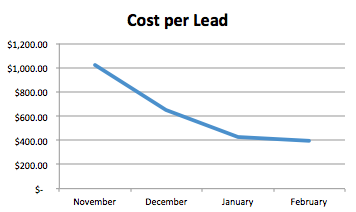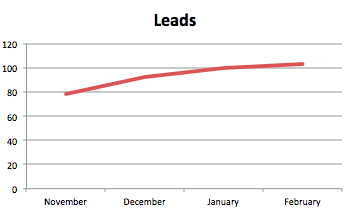Client Profile
One of our clients is the leading water ionizer distributor in the United States. Their revenue is a little over $2 million and their AdWords spend before starting to work with us was $950,000 a year.
The Problem
Even though they were investing $80,000 a month in AdWords clicks, they were only getting 78 leads a month, so their average cost per lead was $1,025.
Our Goal
They told us that in order to make their numbers work we needed to be able to acquire leads at $500 each. It was a tall order because that meant cutting their cost per lead by more than half, but when we went into their campaign and saw how much room for improvement there was we felt confident that we could reach their goal.
The Results
Cost Per Lead
In November of 2012, their cost per lead was $1,025. After optimizing the campaign we were able to reduce their cost per lead to $395.81 (over $100 lower than the goal they had in mind). That’s a 61% decrease in their cost to acquire new leads.

Total Conversions
Because we freed up a huge chunk of their budget by optimizing their campaign, we could acquire more high-quality leads for this client. We went from 78 leads a month to 103 while reducing their monthly budget from $80,000 to $40,000.

How We Did It
- The first thing we noticed was that for some of their keywords they had a really high bounce rate (i.e. the percentage of people staying on the website for just a few seconds). First, we went into their Google Analytics and used advanced segments to isolate their PPC traffic. Then we applied an advanced filter so we could see all the pages with a bounce rate of over 50%. Finally, we sorted the results by the number of visits so we could prioritize the keywords that were costing them the most money. Once we had a final list of the keywords that were sucking up all their budget and not producing results, we started analyzing the landing pages for each keyword. We quickly realized that people were being sent to the wrong landing pages. For example, people searching for “affordable water ionizer” were being sent to the page where they had one of the most expensive products. We went through the entire list to make sure that the landing pages people were presented with were relevant to the search terms they typed into Google. This had a major effect on conversions.
- We pulled a report of all the paid keywords that were generating sales and we sorted the results by the number of sales per keyword. Then we created a landing page and an individual ad for each keyword to improve the performance of these already high-performing keywords. When it comes to optimizing AdWords campaigns, it’s important to look for holes and fix them, but it’s equally important to look for what’s already working so you can do more of it and do it better. And a good PPC agency understands that optimizing an AdWords account is just half of the battle; the other half is optimizing the landing pages so more visitors turn into paying customers.
- They had one campaign for all the different devices: desktops, laptops, iPhones, Androids and iPads. We segmented these campaigns by device and found that their performance on mobile devices was extremely poor even though they were doing great on desktops and laptops. We paused their mobile campaigns until their mobile-friendly website is ready.
- We looked into the Search Terms report, that shows the actual keywords people are searching for and found that they were wasting thousands of dollars every month on bad keywords like “free water ionizer” and “do-it-yourself water ionizer.” These keywords were triggering their ads because they had a broad match keyword (“water ionizer”) and no negative keywords (such as “free” and “do-it-yourself”). We fixed this and we immediately saw a very positive impact on the campaign.
- They were trying to A/B test ads, but they were doing it the wrong way: they were split testing six different ads per ad group (instead of two) and they had ad groups where some ads were converting at 2.8% and some at 0.4% (in this case there is a clear winner so it makes more sense to pause the ad that is performing at 0.4% and write an ad similar to the one performing at 2.8% to compete with it).
- We used the Advanced Dimensions feature in AdWords and we discovered some fascinating facts: their cost per conversion was $551 on Sundays and $265 on weekdays, so we decided to reallocate the budget from Sundays to weekdays for a better performance. Also, from 6am-9am they were getting conversions at $229, whereas conversions between 11pm and5am were $614. We could also see that conversions in Los Angeles were $301 and conversions in New York City were $611. All this information allowed us to move the budget to where it could perform at its best.
Do you want to talk about your PPC campaign? We’re here for you. Have a great day!

